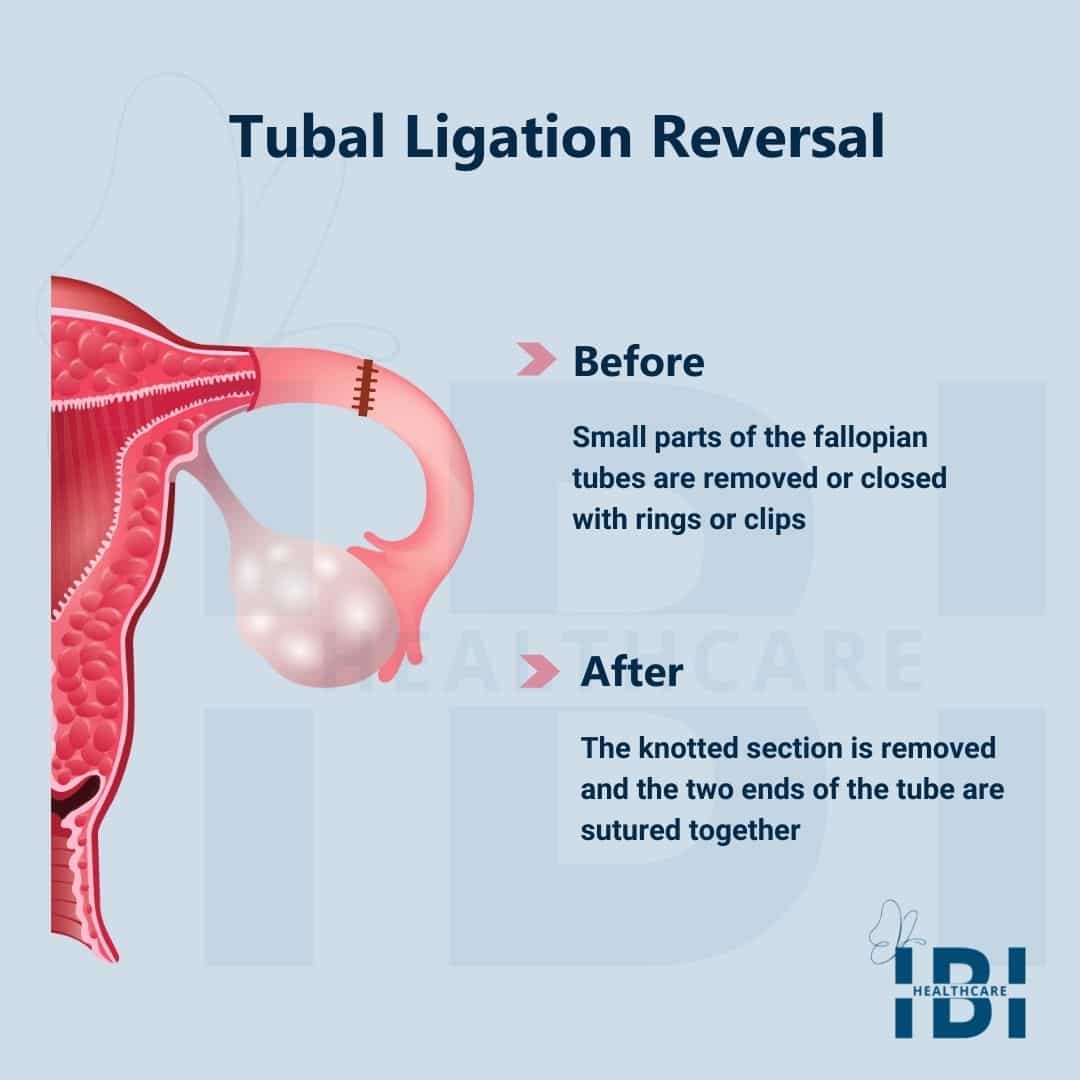What is a Tubal Ligation & Reversal?
Tubal ligation is a surgery that is 99% effective in preventing pregnancy. It is also known as “getting your tubes tied”. The surgery uses one of several methods to block the fallopian tubes to inhibit fertilization of an egg and prevent it from traveling down to the womb.
Surgeons perform a tubal ligation reversal to reconnect or open up the fallopian tubes, allowing sperm to reach the egg and enabling successful conception. The procedure unblocks the egg’s path, facilitating its implantation into the uterus and leading to pregnancy.
How is a Tubal Ligation Reversal Done?
The surgeon can perform a reversal by considering the technique used to perform the original ligation and the condition and health of the fallopian tubes.

Tubal Ligation Techniques That Often Can Be Reversed
Pomeroy Tubal Ligation
Shaping the fallopian tubes into a loop and suturing them together to pinch them closed performs the procedure. Often, cutting and burning the loop at the top is done.
Tubal Ring or False Ring
Tiny elastic bands are used to secure the fallopian tube after it is shaped into a loop. The rings do not usually do any damage to the tubes and the reversal rate is very high.
Tubal Clips (Spring Clip or Hulka Clip)
These locking clips are around 7mm wide and clip onto the fallopian tube close to the uterus blocking off the path of the egg but doing very little damage to the tube.
Tubal Coagulation (Cauterization Done Laparoscopically)
This method damages the ends of the fallopian tube by burning it with an electrical current. Cauterizing the small sections of the tube blocks off those sections to prevent pregnancy. Reversal can sometimes be done depending on how many sections of the tube were cauterized and damaged.
The success of a procedure will primarily depend on the skill of the microsurgeon and how many viable fallopian tubes they have to work with. If the original ligation was done with clips or rings, the process of reversing is not as challenging as if they were burned or cut. Other factors such as age, weight, presence of scar tissue, etc. will also influence how successful a reversal will be.
How Long Does It Take for Tubes to Heal After Tubal Reversal?
The recovery after a tubal reversal normally only takes about two weeks. The surgeon will provide you with instructions on how to best care for yourself while you are on the mend.
Getting Pregnant after a Successful Tubal Ligation Reversal
Many women have questions about getting pregnant and having a baby after a tubal ligation reversal. Following are several frequently asked questions about what you can expect after having a tubal reversal.
1. What Is the Success Rate?
A doctor may successfully perform a tubal ligation reversal to repair the fallopian tubes, allowing for the fertilization of an egg. However, the success rate of becoming pregnant after the procedure may not be the same. The success rate for tubal reversal procedures ranges from between 45-85%.
2. What Is the Easiest Tubal Ligation to Reverse?
Usually, ligations done with clips or rings are the easiest to reverse and offer the highest success rate. During the original procedure, doctors usually use rings or clips, which help to keep the fallopian tubes intact with minimal damage.
Performing tubal ligations through cauterization (burning) can also yield a favorable reversal rate if enough viable fallopian tube remains for reconnection.
3. Is It Easy to Get Pregnant after a Tubal Ligation Reversal?
Becoming pregnant after tubal ligation reversal is generally not difficult for healthy partners without other fertility issues. However, success rates vary based on age. Younger women, especially those under 35, have a higher rate of pregnancy success, ranging from 70-85%. Women over 40, on the other hand, have a lower success rate of 30-40%.
4. Can You Get Pregnant After Having Your Tubes Tied?
Becoming pregnant after a tubal ligation is possible, but it results in an ectopic pregnancy, which is not viable. However, in extremely rare instances, the fallopian tubes may reconnect, leading to a successful pregnancy. Fortunately, as medical procedures like tubal ligation improve, the rate of failure has significantly decreased.
5. How Soon after the Procedure Can I Conceive?
Doctors generally suggest waiting a few months for the body to heal after tubal reversal surgery. Your doctor will advise on the ideal time to begin trying to conceive. Statistically, women often achieve pregnancy within a year after the procedure, although it can happen as early as one month later.
6. How Common is Ectopic Pregnancy after Tubal Reversal?
The risk of ectopic pregnancy or tubal pregnancy rises when any condition or procedure affects the normal function of a woman’s fallopian tube. Normally, the risk is approximately 2.5%. However, after tubal ligation or its reversal, the risk increases to 10%.
7. What Does Ectopic Pregnancy Mean?
If the egg fertilizes and attaches somewhere besides the uterus, doctors consider it an ectopic pregnancy. In many cases, the fertilized egg will attach inside the fallopian tube (tubal pregnancy) where there is no room to grow and no means of survival. If not detected and addressed early enough, it can cause the fallopian tube to rupture causing serious life-threatening internal bleeding.
8. How Would I Know if My Pregnancy after Tubal Ligation Reversal is Ectopic?
If you are experiencing an ectopic pregnancy you must receive immediate medical attention. Some of the symptoms you may experience are:
- Pelvic pain.
- Fainting spells.
- Extreme lightheadedness.
- Pain in the abdominal region, often low down on one side.
- Vaginal bleeding is usually different than your regular period; bleeding is intermittent, watery with a dark brown color.
9. What If Tubal Ligation Reversal Does Not Work?
If tubal reversal surgery fails or you are ineligible, consider using IVF or intrauterine insemination for pregnancy.
In-vitro Fertilization (IVF)
A procedure that harvests eggs from the female partner and extracts sperm from the male partner. Scientists choose healthy eggs and sperm and join them together to “fertilize” the egg. They then implant the fertilized eggs into the female’s womb in hopes that one of the eggs will correctly implant and result in a viable pregnancy. IFV involves a multi-step process for the female partner including a round of birth control pills, hormone shots, etc.
Intrauterine Insemination (IUI)
This procedure gathers sperm from the male partner and separates the stronger viable ones from the rest. The doctor introduces this sperm into the female partner’s uterus using a small painless catheter. People commonly use this process when the male partner has sperm issues like count, size, or shape. The doctor prescribes medications to the female to stimulate ovulation for higher success. This method is less expensive than IVF and may be a viable option for those with sperm-related infertility issues.
Furthermore, if you have had a tubal ligation and desire to get pregnant, contact IBI Healthcare Institute. Above all, your health and concerns are our top priority and we will discuss the tubal ligation reversal procedure and determine if this procedure is right for you.











